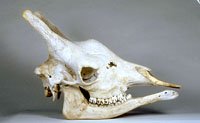|
An unlikely design which has turned out to be very successful, flourishing in areas where most other megafauna are endangered. The giraffe is highly adapted for treetop browsing; it is the tallest living mammal and, as well as its long legs and neck, has adaptations of the rear of the skull to enable the head to be tilted vertically.
The horn-like ossicones, present in both sexes, are unique to Giraffids, being formed from ossified cartilage, permanently covered with skin and never shed. They develop over the suture between the frontal and parietal bones, unlike other artiodactyls whose horns always develop from the frontals. Further horn-like protruberences may develop in adult giraffes on the frontal and nasal bones, indicating the importance of the head as a weapon in fights between giraffes. |

1. Giraffe skull, male, lateral view
Click for larger image
|

2. Giraffe skull, female, lateral view
Click for larger image
|
Internet Resources
Standard references :
American Society of Mammalogists Monographs
Smithsonian / Wilson & Reeder's Taxonomic List
University of Michigan Animal Diversity Web
|
|
Taxonomy:
Order - Artiodactyla (cloven-hoofed)
Family - Giraffidae (giraffe & okapi)
Scientific Name:
Giraffa from the Arabic zarafa "swift walker"
camelopardalis "camel that looks like a leopard" (Latin)
Dental Formula
U 0.0.3.3 - L 3.1.3.3 The incisiform canines are lobed giving the appearance of extra teeth.

Measurements: (defined)
Sorry, no measurements
Collection Data
Photo 1
Stage - adult
Sex - male
Area collected - USA
Source - died in captivity
Photo 2
Stage - adult
Sex - female
Area collected - USA
Source - died in captivity
|

